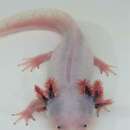Brief Summary
provided by EOL authors
Amphibians are vertebrates of the taxonomic class Amphibia including animals such as frogs and toads (order Anura), salamanders (order Caudata), and caecilians (order Gymnophiona). Thought of as cold-blooded, amphibians are ectotherms, meaning they are unable to regulate their own body temperature independently of the temperature of their surroundings. Amphibians are generally small with thin skin permeable to air and water. With few exceptions, amphibians do not actively care for their young. In general, amphibian reproduction strategy consists of egg-laying and external fertilization of a large number of eggs in a moist or fully aquatic environment. Fertilized eggs develop into amphibian larvae that live part of their lives dependent on an aquatic environment requiring gills and specialized feeding habits. Following a pattern of development unique to amphibians, amphibian larvae undergo marked changes and metamorphose into a terrestrial form that lives on land. Typically, this metamorphosis is demonstrated by loss of gills, changes in overall appearance, and changes in diet.Amphibians live in diverse habitats, often in large numbers, and play several important ecological roles. As consumers, amphibians help regulate populations of the organisms they consume, chiefly invertebrates. As prey items, amphibians are consumed by a variety of larger predators such as reptiles, birds, mammals, fish, predatory invertebrates, and other amphibians. When consumed by larger predators, amphibians transfer the energy and nutrients from amphibian prey items such as small invertebrates to larger predators.
- license
- cc-publicdomain
- copyright
- National Biological Information Infrastructure (NBII) at http://www.nbii.gov
AmphibiaWeb Mobile App
provided by EOL authors
The AmphibiaWeb app provides mobile access to AmphibiaWeb and gives information about all amphibian species (frogs and toads, salamanders and newts, and caecilians), including pictures, sounds, as well as range maps and specimen collection points. The app will find all amphibians around one's current location, or, one can search for amphibians in any location around the world or by name. One can browse through the amphibians by name or image.
This app is based on data from AmphibiaWeb, an online system that provides access to information on amphibian declines, conservation, natural history, and taxonomy.
Range maps displayed derive from the IUCN Global Amphibian Assessment, 2010-2012.
An internet connection (wifi or cellular) is required.
App Developer, Mel Roderick
Available on iTunes:
https://itunes.apple.com/us/app/amphibiaweb/id476890286?mt=8
Global Amphibian BioBlitz
provided by EOL authors
Amphibians around the world are rapidly disappearing. To conserve these fascinating creatures, scientists need your help!
Learn more about this project
North American Amphibian Monitoring Program
provided by EOL authors
NAAMP volunteers contribute their time to help states and USGS to assess frog and toad population trends. Data are collected using a calling survey technique, in which volunteers identify local amphibian species by their unique breeding vocalizations or calls.
Learn more about this project.
The Maryland Amphibian and Reptile Atlas (MARA)
provided by EOL authors
Volunteers are needed to document the statewide distribution of Maryland’s amphibians and reptiles. The goal of the MARA project is to document the current distributions of Maryland’s amphibian and reptile species using a systematic and repeatable approach.
Learn more about this project

